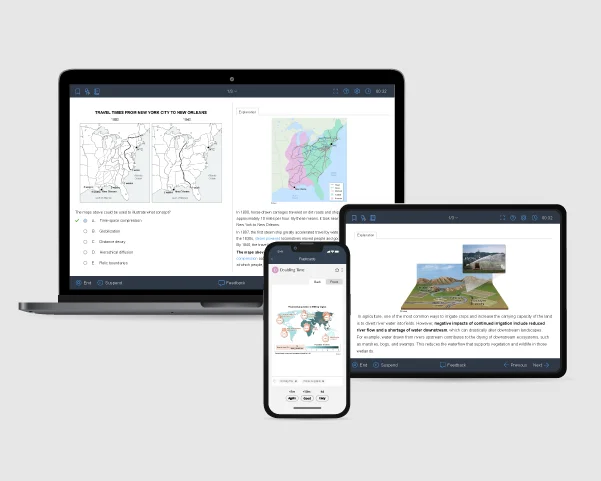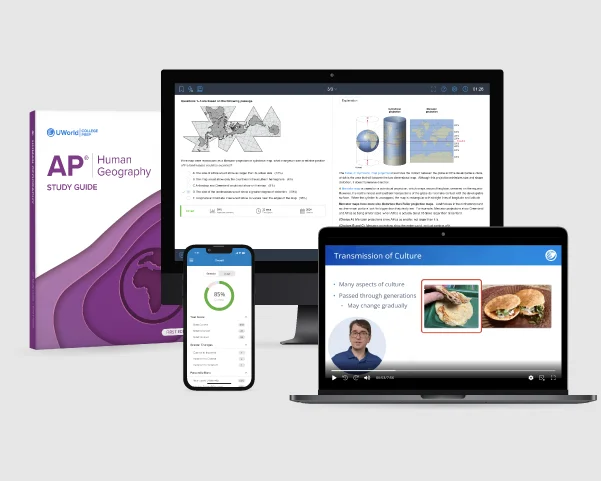In AP Human Geography (AP HUG), students study the factors and processes that have influenced the use of spatial theories and landscape analysis to look into social and economic structures and how they affect the environment. In essence, AP HUG delves into the fascinating connections between people and the places they live, along with the methods and technologies used by geographers to discover these connections.
What Is AP Human Geography Equivalent to & Who Can Take It?
AP Human Geography is equivalent to an introductory college-level course in human geography or cultural geography. In most colleges, HUG is classified as a social science class.
AP HUG is typically taken by 9th or 10th grade students, and requires no prerequisites. However, students enrolling in the course should be comfortable reading college-level textbooks and writing well-structured sentences.
What Is on the AP Human Geography Exam?
The AP HUG exam assesses students on two aspects: their knowledge of the subject and the units covered during the course, and the skills they’ve acquired while studying these units. Each unit is further divided into multiple topics, which you can learn about in our AP Human Geography course description guide.
AP Human Geography consists of themes based on the National Geography Standards, published in 1994 and updated in 2012. The AP Human Geography curriculum focuses on five college-level skills. Listed below is an outline of the five skill categories and associated skills that AP Human Geography students must master. These skills serve as the foundation for AP exam tasks, and successful completion of the course ensures an understanding of:
- Concepts and Processes: Analyze geospatial data and interpretation of maps
- Spatial Relationships: Understand and explain spatial associations and networks
- Data Analysis: Identify and interpret patterns and processes at distinct scales
- Source Analysis: Defining and assessing regions
- Scale Analysis: Analyze the changing connections between places
The AP Human Geography exam also tests a student’s knowledge of the three “Big Ideas” of the course themes. The big ideas are the course's foundation, helping students make authentic learning connections. These big ideas are often abstract concepts or course themes. The AP HUG “Big Ideas” are as follows:
Patterns and Spatial Organization (PSO):
Human society's spatial patterns and organization are based on political, historical, cultural, and economic factors.
-
Impacts and Interactions (IMP):
People, their environments, and historical and contemporary behavioral patterns have complex cause-and-effect relationships.
Spatial Process and Societal Change (SPS):
A spatial perspective examines how phenomena are related in specific places to examine human organization and their relationship to the environment.
The course material is organized into seven units of AP Human Geography, each with its respective weight on the AP exam:
| Units Tested | Exam Weight |
|---|---|
| Unit 1: Thinking Geographically | 8–10 % |
| Unit 2: Population and Migration Patterns and Processes | 12–17 % |
| Unit 3: Cultural Patterns and Processes | 12–17 % |
| Unit 4: Political Patterns and Processes | 12–17 % |
| Unit 5: Agriculture and Rural Land-Use Patterns and Processes | 12–17 % |
| Unit 6: Cities and Urban Land-Use Patterns and Processes | 12–17 % |
| Unit 7: Industrial and Economic Development Patterns and Processes | 12–17 % |
AP Human Geography Exam Format for 2025
The AP HUG exam tests students' understanding of course skills and objectives. It is two hours and fifteen minutes long and is divided into two parts: multiple-choice (MCQ) and free-response (FRQ) questions. Each section accounts for 50% of the overall exam grade.
| Sections | Question Types | Time Allocated | Weight |
|---|---|---|---|
| Section I | 60 MCQs | 60 minutes | 50% |
| Section II | 3 FRQs | 75 minutes | 50% |
Let us explore each of these question types.
Section I: Multiple-choice (MCQ)
MCQs have five answer choices and two types: individual and set-based questions (5 to 8 sets of two to three questions each). You will be expected to do the following in this section:
- Interpret maps and spatial data.
- Demonstrate a solid understanding of how the world appears from a spatial standpoint.
- Analyze patterns and processes at various scales.
- Recognize various regions
- Characterize and examine changing interactions between locations.
Section II: Free-response (FRQ)
The free-response part of the AP Human Geography test has three questions, each of which tests at least two units. It requires you to make connections between different subject areas and to analyze and evaluate geographical ideas. Verbal descriptions, maps, graphs, photos, and diagrams may be used as question prompts. Your essays must show analytical and organizational skills. Answer each question as it is structured; points are given for sub-parts, not the overall answer.

Why take AP Human Geography?
Taking AP Human Geography can prepare you for college-level coursework, boost your college readiness, potentially save on tuition costs, and provide a strong academic foundation for your future studies. According to the College Board®, AP Human Geography is the most popular course taken by students in their 9th and 10th grades. 56.1% of the 262,253 students who took the AP HUG exam in 2024 earned a score of 3 or higher.
Let’s explore how taking AP Human Geography can benefit you:
- AP Courses Readiness: AP HUG is designed to give you a taste of AP without being too difficult. Because there are usually no other AP courses to worry about, this is a great way for freshmen to adjust to the higher-level curriculum in high school.
- College Readiness: Some schools give more weight to AP courses than pre-AP or regular courses when calculating GPA. So, if you take AP Human Geography as a freshman, you will be ahead of your other classmates. According to College Board research, students who score 3 or higher on AP exams have greater academic success in college and higher graduation rates.
- College Credits: Taking AP courses allows you to earn college credit while in high school. Passing the AP Human Geography exam can earn you up to three hours of college credit.
- Tuition Savings: Students who enter college with pre-earned credits can save money on tuition and have the opportunity to graduate early or explore more advanced courses or courses outside of their major.
- Strong Foundation: AP HUG prepares you for an introductory human geography course in college. It will boost your confidence and skills for harder classes. You will have adapted to college's pace, giving you an advantage.
Should I Take AP Human Geography?
Taking AP Human Geography is a good option for students who wish to develop critical thinking, analytical, and research skills, while also deepening their understanding of the world and fostering their interest in geography and global affairs. AP HUG provides insights into the interconnectedness of the world, helping students understand how human societies, cultures, and economies interact on a global scale. This knowledge is increasingly important in an interconnected and globalized world. The course also emphasizes the analysis of patterns and processes at different scales, helping you develop strong analytical skills that can be applied in various contexts.
Overall, AP Human Geography can offer you a broader perspective on the world, equip you with valuable skills, and nurture a deeper curiosity about the complexities of human geography and the global landscape.
What kind of student succeeds in AP HUG?
- They ask "why" things happen or work.
- They enjoy reading.
- They link seemingly unrelated things.
- They enjoy social studies courses and topics.
- They use time well.
- They understand cause and effect.
Is AP Human Geography Hard?
AP Human Geography is often regarded as one of the more approachable AP classes, though it does require extensive preparation. It's worth noting that AP HUG is on par with a college-level course and can be demanding without a consistent study plan and regular practice.
Struggling with tough concepts? Our AP HUG study guide provides clear, comprehensive content coverage that helps you grasp even the most challenging topics with ease.
The following is the AP Human Geography exam’s score distribution information:
| AP Score | 2024 | 2023 | 2022 | 2021 |
|---|---|---|---|---|
| 5 | 17.9% | 16% | 14.9% | 15% |
| 4 | 20.5% | 20% | 18.7% | 20% |
| 3 | 17.8% | 18% | 19.6% | 19% |
| 2 | 14.3% | 14% | 15.0% | 16% |
| 1 | 29.5% | 32% | 31.8% | 31% |
AP Human Geography Review Tips
Make sure to incorporate the following strategies during your AP exam prep:
- Before writing your responses, plan them out. This helps you organize your thoughts, determine the question's parts, and compare individuals or occurrences that may be required to respond accurately.
- Incorporate evidence into your response. Before responding, examine any relevant maps, charts, graphs, or diagrams. Consider how any evidence from the course relates to the question. Do they present contradictory information? Evaluate how many illustrations or explanations are required for you to explain your answer with clarity.
- Explain the evidence. No paraphrasing! Compare the evidence, then state your purpose in an argument supported by data. Your response should display a thorough comprehension of the topic. Respond carefully. Make sure to use geographical terms, theories, and models that you learned throughout the year.
- Practice. The most important thing is to practice answering MCQs. Practicing with exam-style questions from UWorld’s AP Human Geo QBank will help you become acquainted with the MCQ rubric and develop your skill of analyzing a question and answering it to the point with clarity.
You will improve your GPA and ace your exam if you prepare with UWorld, enroll for our AP HUG prep course, apply your content knowledge and skills in the classroom, and follow a well-thought-out AP HUG study plan.

Frequently Answered Questions (FAQs)
What to bring to the AP Human Geography exam
- A watch.
- A school-issued or government-issued photo ID (required if testing at a school other than your own).
- A fully charged device and its power cord.
- College Board account login details.
- Pens or pencils for writing on scratch paper provided by the school.
- Optional: An external mouse.
- External keyboard requirements: Must be used if testing on a tablet or iPad. Not allowed for students using a laptop.
Please refer to the AP Exam policies and accommodations to learn more about the do’s and don’ts on your AP exam day.
Where can I find past AP Human Geography exam questions?
When is the 2025 AP Human Geography exam?
What happens if you fail the AP Human Geography exam?
When do students usually take AP Human Geography?
How much does the AP Human Geography exam cost?
References
- (2023). Most Popular AP®Courses. College Board. Retrieved December 11, 2024, from https://apcentral.collegeboard.org/about-ap/start-expand-ap-program/build/most-popular-ap-courses
- (2023, June 29) Packer, T. 2024 AP Human Geography scores. Twitter. Retrieved December 11, 2024, from https://x.com/AP_Trevor/status/1803895607267864633
- (2020, Fall). AP® Human Geography Course and Exam Description. College Board. Retrieved December 11, 2024, from https://apcentral.collegeboard.org/media/pdf/ap-human-geography-course-and-exam-description.pdf
- (2025). What Students Should and Should Not Bring. College Board. Retrieved December 16, 2024, from https://apcentral.collegeboard.org/exam-administration-ordering-scores/administering-exams/preparing-for-exam-day/what-students-can-cannot-bring
Read More About the AP Human Geography Exam
AP Human Geography Exam Format
Understanding the exam structure will give a kick-start to your AP HUG prep. Therefore, we have compiled an easy-to-read article discussing the exam format, question types, and more.
AP Human Geography Course and Exam Description
Navigating the lengthy College Board’s Course and Exam Description can be overwhelming. Click here for a concise summary of all units, topics, and essential course skills in AP HUG.
AP Human Geography Scoring Guide
Wondering how to predict your AP test scores? Here is a detailed article on the AP Human Geography scoring system, along with a score calculator to help you estimate scores easily.
AP Human Geography Study Plan & Tips
Take advantage of our simple-to-understand AP Human Geography study plan and the most effective tips created by experts to gain prestigious school admissions with ease.
Best AP Human Geo Study Guide Comparison
Compare the best AP Human Geo study guides! See how Kaplan, Barron's, and Princeton Review stack up against UWorld for comprehensive exam prep.
Best AP Human Geo Prep Course Review
Searching for top AP Human Geo prep courses? Read this review to compare the best courses and choose the perfect one for your success.




